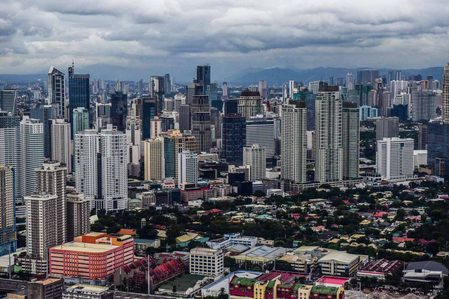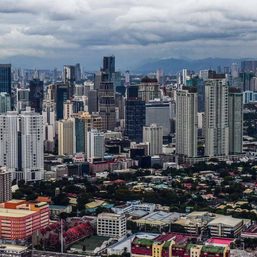SUMMARY
This is AI generated summarization, which may have errors. For context, always refer to the full article.
![[Vantage Point] Joey Salceda says 8% GDP growth attainable](https://www.rappler.com/tachyon/2024/04/tl-salceda-gdp-growth-04192024.jpg)
The country’s realignment to the West and Japan, a policy adopted by President Ferdinand Marcos Jr., will shield the Philippines from the ill-effects of a flagging Chinese economy. It will keep the country’s inflation in check, with Filipino consumers continuing to enjoy cheap imported products, due in part to the export subsidy the Chinese government resorts to in order to keep its products competitive.
This is what Congressman Joey Salceda believes, as he expressed optimism on the economic prospects of the Philippines in the immediate foreseeable future, “[if] we can build on our strengths.”
As one of the most dynamic economies in the East Asia and Pacific region, the Philippines is taking advantage of increasing urbanization, a growing middle class, and a large young population that result in a strong consumer demand, buoyed by a vibrant labor market and robust remittances.
The Filipino workforce enjoys a unique edge over other Asian countries in terms of labor quality. Aside from 51% of the population aged 25 and younger, the country also has a 94.6% literacy rate.
This year, the Philippine economy is estimated at ₱26.55 trillion, making it the world’s 32nd largest by nominal gross domestic product (GDP) and the 13th largest in Asia, according to the International Monetary Fund (IMF).
The country’s economy is also transitioning from one based on agriculture to one based more on services and manufacturing. Records show that it has experienced significant economic growth and transformation in recent years. The IMF also noted that the Philippines has emerged as one of the fastest-growing economies in the world, with an average annual growth rate of around 6% since 2010, BusinessWorld reports in its latest World Economic Outlook (WEO) that the IMF upwardly revised its Philippine growth forecast to 6.2% for this year from 6% previously. This is within the government’s revised 6-7% growth target.
“Real GDP growth for 2024 was revised slightly to 6.2% from the January WEO forecast of 6%, reflecting carryover from a better-than-expected outturn in the last quarter of 2023.” IMF Representative to the Philippines Ragnar Gudmundsson said in an e-mail to BusinessWorld. The Philippine economy grew by 5.5% in both the fourth quarter and full-year 2023.
China’s challenges
Based on IMF projections for emerging and developing Asia, the Philippines is expected to post the second-fastest GDP growth this year, just behind India (6.8%). It is ahead of Vietnam (5.8%), Indonesia (5%), China (4.6%), Malaysia (4.4%) and Thailand (2.7%).
“Growth in emerging and developing Asia is expected to fall from an estimated 5.6% in 2023 to 5.2% in 2024 and 4.9% in 2025, a slight upward revision compared with the January 2024 WEO Update,” according to the report.
China, the world’s second largest economy, is facing challenges, such as declining property investment, debt risk, and weak consumption growth. Growth is slowing, prices are falling, and exports and imports have plummeted. The real estate crisis has deepened, and foreign investors have fled the stock market.
“Even if we do nothing right, our growth rate will not go below 4.0 percent,” Salceda said.
Salceda said that China is experiencing an economic downturn which will negatively affect ASEAN countries, but not the Philippines.
It is against this backdrop that Salceda based his forecast. In a brief speech delivered on April 8 this year before the Monday Circle Financial Forum, the economist-turned-lawmaker predicted that the Philippines will clock in the fastest growth among members of the Association of Southeast Asian Nations (ASEAN), except Vietnam (the unchallenged economic powerhouse). That is, “if we don’t create self-restraints, such as slow disbursement of government funds.”
He, however, advised his audience at the forum not to put too much weight on the announcement made by the Development Budget Coordinating Committee, that it is adjusting its GDP growth target downward from 6.5% to 8.0% to 6.5% to 7.5%. As Salceda puts it, it is “too much ado about nothing.”
The country should always aim for an 8% growth, Salceda believes, just as Gloria Macapagal Arroyo did when she was president. As a result, the growth rates during the last two quarters of her presidency were 8% and 8.1%, respectively.
According to Salceda, growth has always been easy for the Philippines due to the country’s high fertility rate, expected to decline only by 2992, which is a good thing for the economy as it creates a young and strong labor force.
In the Philippine context, inflation is driven by the increase in rice prices. The good news is that the Indian government will immediately lift the ban on rice export after the national elections, and that will depress the prices in the world market to the advantage of rice-importing countries like the Philippines. The government of India has imposed the ban to keep the prices of the cereal down and placate their electorate. – Rappler.com
Add a comment
How does this make you feel?

![[In This Economy] Looks like PH economy will never get back on track. Here’s the data.](https://www.rappler.com/tachyon/2024/02/20240202-PH-economy-back-on-track.jpg?fit=449%2C449)
![[In This Economy] Is the Philippines quietly getting richer?](https://www.rappler.com/tachyon/2024/04/20240426-Philippines-quietly-getting-richer.jpg?resize=257%2C257&crop=194px%2C0px%2C720px%2C720px)
![[In This Economy] Looks like PH economy will never get back on track. Here’s the data.](https://www.rappler.com/tachyon/2024/02/20240202-PH-economy-back-on-track.jpg?resize=257%2C257&crop=289px%2C0px%2C720px%2C720px)

![[In This Economy] Something’s broken, and it’s hidden by ‘high’ economic growth](https://www.rappler.com/tachyon/2023/11/something-broken-hidden-economic-growth-November-10-2023.jpg?resize=257%2C257&crop=276px%2C0px%2C720px%2C720px)
There are no comments yet. Add your comment to start the conversation.